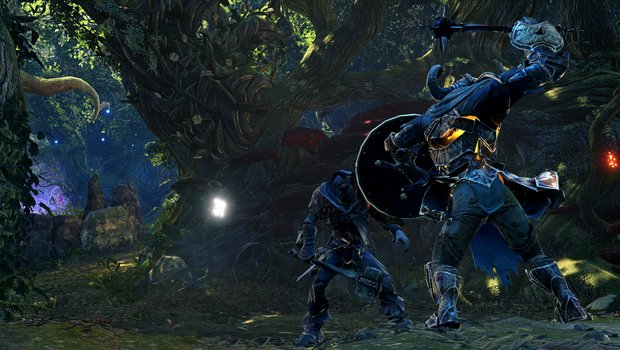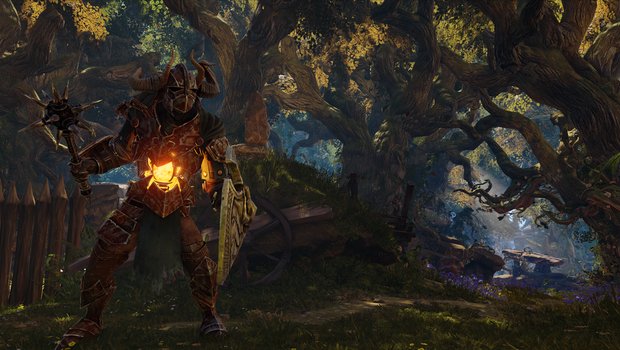Fable Legends is not so much a gamble as a collection of high-risk wagers. The first and most obvious is the drastic departure it represents for the series which offers, traditionally, a humorous romp through Albion, a fantasy land amalgam of old English folk tales, Robin Hood-style heroics and Monty Python-esque absurdity. Fable Legends certainly keeps the style and mythology of its forebears, but discards the traditional game elements entirely.
This is, instead, a five-player competitive battle in which four warriors hack, slash, spell and shoot their way through waves of evil minions, which have been sent to thwart them by the fifth, opposing player, who plays an entirely different sort of game. It is, in other words, an asymmetrical, four-versus-one kind of sport that has nothing in common with the Fables of yore, save for the mossy trees and fart gags.

Then there’s the worry about the way the game is sold or, more accurately, isn’t sold. Fable Legends will be, controversially, a free-to-play title that anyone any one with an Xbox One or PC can download gratis. Free-to-play has a mixed reputation, especially among traditional console audiences, who fear being nickel-and-dimed with restricted access to content and characters. The game’s developer, Lionhead, is eager to assure fans that this won’t be their modus operandi. Instead, the game, which allows console and PC users to play together, boasts a similar payment model to that seen in League of Legends, the world-conquering MOBA.
Players will have access to four of the game’s expanding cast of heroes (new heroes will be released every few weeks) on a rotating basis. Grow attached to a character and you can pay a small fee (either using real money, or ‘silver’, a collectible currency in the game) in order to use them whenever you want, not just when they are in the free rotation. The creators hope to make its money by convincing you to invest in certain heroes as well as, of course, offering a vast array of different hats and items with which to customise those characters.
This approach is a gamble, not only because free-to-play is a loaded term, but also because, unlike League of Legends, this game is not being positioned as a competitive eSport. There aren’t two-equally arranged sides and, according to David Eckelberry, Fable Legend’s director, this set-up makes the game “an absolute nightmare to balance.” Without a healthy competitive scene around the game, is it possible for Fable Legends to achieve the kind of success seen by its newfound rivals in the world of PC strategy games?

“It’s theoretically possible for Fable Legends to become an eSport,” Eckelberry says. “But that’s not our focus right now. Then again League of Legends wasn’t an eSport for two or three years into its life. So our aim is to see how the players receive the game. If they want more quests and story then that’s what we’ll focus on. If they want a more finely tuned high-level play, then we will take our energies there.”
The game, which is in closed beta testing at the moment, is, in other words, something of a hedged bet. The team is eager to assure Fable fans that the game will present story-based adventures set in Albion and that the British sense of humour for which the game is known will remain intact. But it's all somewhat at odds with the rapid-fire nature of competitive online multiplayer games.
Weekly digests, tales from the communities you love, and more
The story (which predates the first Fable and is a return to the series’ fairy-tale roots, away from Fable 3's grim industrial revolution) will be delivered in ‘seasons’ of content (in Lionhead’s phrase), rolled out across the months. Initially, you will make their way to the city of Brightlodge, in the South of Albion. There you will find a metropolis under siege, as well as a central hub in which to hang-out between matches.
Exploring the hub allows you to interact with villagers, visit shopkeepers, upgrade your chosen hero’s appearance, and engage in the kind of minigames for which Fable is known (including, according to the team, the return of chicken-kicking). New chapters and areas in the story will be accessed from a war table (another nod to the earlier games), at which point you will be paired with other players and enter the match proper.

Each match has a natural rhythm. At the start the team of four heroes wait in a holding area while the so-called villain player lays traps and sets the positions of his minions, dividing action points between archers, melee squads and ‘lobbers’, who send flaming boulders flying through the sky toward the heroes. While everyone’s waiting for the match to begin, the story plays out in the environment.
After 90 seconds or so of villainous prep, the heroes are let out and head into the first area. This pattern repeats as the team progresses (although, if the villain’s troops manage to down all four players at once, the game is immediately over), with pauses before each new stage while the villain sets up. In the final area, the heroes must activate four portals. If they’re successful, they win the match.
Each hero has a motivating backstory. Sterling, a quick-footed melee character, is one of Albion’s bored elite who has joined the defending forces of Brightlodge as he wants to see the world. Rook is an archer from the far North who recently parted ways with her garrison of soldiers for unknown reasons. Evienne uses acrobatics to move like flowing water across the battlefield (she was, the teams says, inspired by Devil May Cry’s protagonist Dante). Malice, by contrast, is a bulky offensive tank character, a dark knight who looks as though he just stepped from the set of Dark Souls.

Each hero has a similar control scheme but vastly different skills and abilities (some even have different camera configurations, including a Gears of War-style over-the-shoulder viewpoint). Malice, for example, is able to control minions that temporarily serve him on the battlefield. He can even detonate them and teleport to their positions. Evienne, meanwhile, is able to lay traps that damage passing enemy units. Likewise, characters can be levelled up over multiple matches (Eckelberry says that the cap will be around level 25, to encourage players to try out a range of different heroes).
Perhaps the most worrying conflict at the heart of the game is the way in which it attempts to combine the nippy tempo of sport with the lingering drama of an RPG storyline. This is a philosophical rift at the heart of the game that will be tough to resolve. When a team of players unites ready to take on a human opponent, the last thing they want to do is sit through a series of dramatic interludes that explain the surrounding story.
“Yes, there is absolutely a tension there,” says Eckelberry. “But there aren’t cinematics in the sense that you’re forced to watch them during load screens and so on. You can ignore the story while waiting in the holding areas and, likewise, the conversations between heroes are opt-in. If you don’t press the button, then they won’t chat to each other. We’re trying to offer Fable fans a way into the game that feels familiar and comforting. And if they want to play the entire game alongside AI team-members, as if it were a single player adventure, then that’s something they can do.”
Despite these risks, early signs are, according to the team, favourable. “The beta retention numbers are fantastic,” says Eckelberry. “It’s a difficult game to explain to people, but once you’ve played it all becomes clear. That’s why we’ve gone free-to-play. With great multiplayer titles, the more of your friends that are playing the better your experience will be.” He’s also eager to point out that Microsoft, who is publishing the game, is allowing Lionhead to be generous to players who don’t want to pay anything.
“Everything that affects gameplay can be earned. And there’s no way in which to buy your way to a high level character. My hope is that people will have such a good time that, after thirty hours spent playing the game, they will want to pay some money as a way to express their gratitude. That’s the best possible way, isn’t it?”
The official source for everything Xbox One, Xbox 360, and Xbox Series X. We're also a magazine, covering all things Xbox in the UK and the US. Originally established in 2001, the magazine was discontinued in April 2020.



